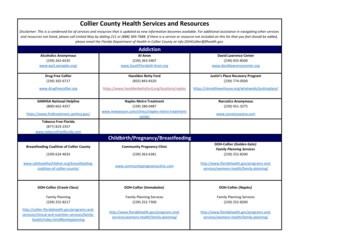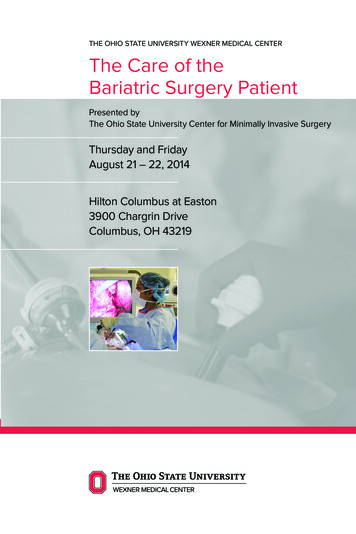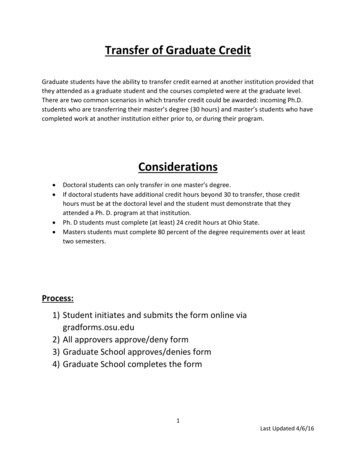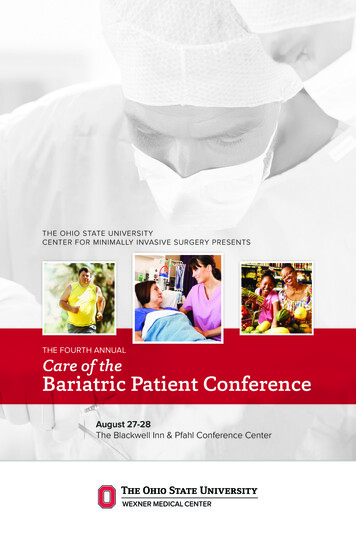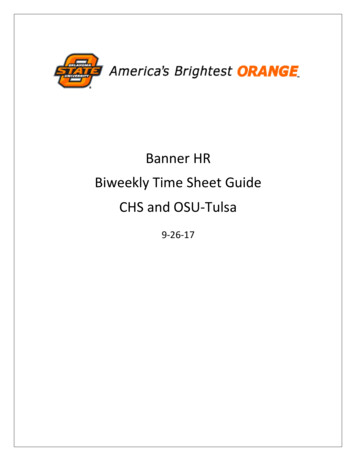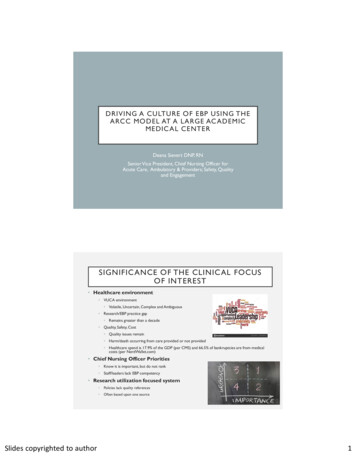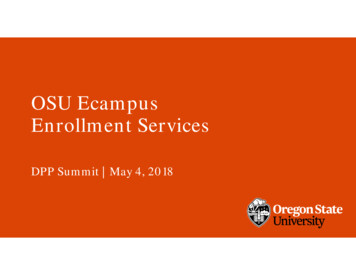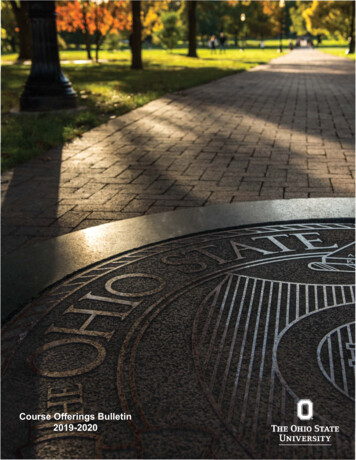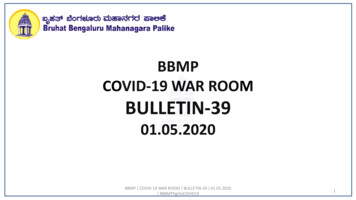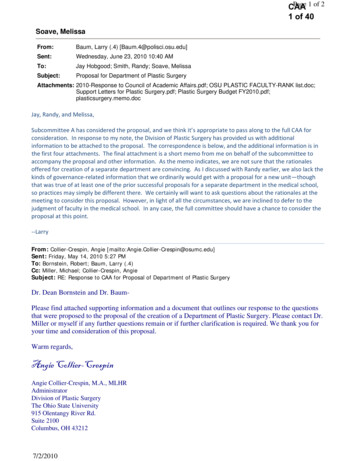
Transcription
Page 1 of 2CAA1 of 40Soave, MelissaFrom:Baum, Larry (.4) [Baum.4@polisci.osu.edu]Sent:Wednesday, June 23, 2010 10:40 AMTo:Jay Hobgood; Smith, Randy; Soave, MelissaSubject:Proposal for Department of Plastic SurgeryAttachments: 2010-Response to Council of Academic Affairs.pdf; OSU PLASTIC FACULTY-RANK list.doc;Support Letters for Plastic Surgery.pdf; Plastic Surgery Budget FY2010.pdf;plasticsurgery.memo.docJay, Randy, and Melissa,Subcommittee A has considered the proposal, and we think it’s appropriate to pass along to the full CAA forconsideration. In response to my note, the Division of Plastic Surgery has provided us with additionalinformation to be attached to the proposal. The correspondence is below, and the additional information is inthe first four attachments. The final attachment is a short memo from me on behalf of the subcommittee toaccompany the proposal and other information. As the memo indicates, we are not sure that the rationalesoffered for creation of a separate department are convincing. As I discussed with Randy earlier, we also lack thekinds of governance‐related information that we ordinarily would get with a proposal for a new unit—thoughthat was true of at least one of the prior successful proposals for a separate department in the medical school,so practices may simply be different there. We certainly will want to ask questions about the rationales at themeeting to consider this proposal. However, in light of all the circumstances, we are inclined to defer to thejudgment of faculty in the medical school. In any case, the full committee should have a chance to consider theproposal at this point.‐‐LarryFrom: Collier-Crespin, Angie [mailto:Angie.Collier-Crespin@osumc.edu]Sent: Friday, May 14, 2010 5:27 PMTo: Bornstein, Robert; Baum, Larry (.4)Cc: Miller, Michael; Collier-Crespin, AngieSubject: RE: Response to CAA for Proposal of Department of Plastic SurgeryDr. Dean Bornstein and Dr. BaumPlease find attached supporting information and a document that outlines our response to the questionsthat were proposed to the proposal of the creation of a Department of Plastic Surgery. Please contact Dr.Miller or myself if any further questions remain or if further clarification is required. We thank you foryour time and consideration of this proposal.Warm regards,Angie Collier-CrespinAngie Collier-Crespin, M.A., MLHRAdministratorDivision of Plastic SurgeryThe Ohio State University915 Olentangy River Rd.Suite 2100Columbus, OH 432127/2/2010
Phone: 614-366-1178Fax: 614-293-9024E-mail: angie.collier-crespin@osumc.eduPage 2 of 2CAA2 of 40From: Baum, Larry (.4) [mailto:Baum.4@polisci.osu.edu]Sent: Friday, April 02, 2010 7:56 AMTo: bornstein.1@osu.eduSubject: propopsal for department of plastic surgeryDean Bornstein:I’m chair of the subcommittee of the Council on Academic Affairs that reviewed the proposal. Thesubcommittee has some questions about information that we think would be useful to the full CAA when itconsiders the proposal, and I’ve attached a memo describing those questions. As indicated in the memo, someof the questions are best addressed in a supplement to the proposal; others can be addressed in writing, whenrepresentatives of the medical school discuss the proposal with the full committee, or both.Please let me know if you have any questions. We appreciate your help.‐‐Larry Baum, Political Science7/2/2010
CAA3 of 40
CAA4 of 40
CAA5 of 40Last t BrianRobertMichaelAnnePankajWilliamUpdated: 5/14/2010Year 00620072007TitleAssistant. Professor-ClinicalAssociate. ProfessorClinical Assistant. ProfessorAssistant Professor-ClinicalProfessor-ClinicalAssistant. ProfessorProfessorAssistant Professor -ClinicalAssistant ProfessorProfessorProfessorClinical Assistant ProfessorAssistant ProfessorAssistant Professor -Clinical
CAA6 of 40
CAA7 of 40
CAA8 of 40DATE: June 23, 2010TO: Council on Academic AffairsFROM: Larry Baum for Subcommittee A (Leslie Alexander, John Tannous, John Wilkins)RE: Proposal for a Department of Plastic SurgeryThis short memo is to provide some background on the proposal as the Council considersit. Plastic Surgery has long been a division within the Department of Surgery, and the MedicalCenter is now proposing that it be made a separate department. The proposal presents severalrelated rationales for this action. These include the growing distinctiveness of plastic surgery asa field, a perceived trend toward creation of separate departments of plastic surgery, and a beliefthat plastic surgery at OSU will be strengthened by gaining the status of a separate department.As the proposal points out, other areas that had been within the Department of Surgeryhave been made separate OSU departments in the last decade--orthopedic surgery, neurologicalsurgery, and (most recently) urology. The proposal presents the idea of creating a separateDepartment of Plastic Surgery as analogous to those earlier developments.The proposal is relatively brief, and it provides little information on issues such asgovernance of the new unit and the effects of the change on faculty and students--issues onwhich proposals to create new units ordinarily provide detailed information. This approach isconsistent with the proposal for a Department of Urology, which was similarly limited in theinformation that it contained. The subcommittee did ask for additional information on someissues in a note to Dr. Bornstein on April 2nd; that note and the responses that we received arepart of the package that accompanies the proposal.The evidence on some of the rationales for creation of a separate department is mixed.Although there may be a trend toward creation of separate departments of plastic surgery, suchdepartments remain the exception to the rule in medical schools. The division of plastic surgeryat OSU has done very well in important respects (such as recruitment of faculty) despite the lackof department status. However, the broad perception in the medical school that this step isdesirable and the precedents of earlier steps analogous to this one may be more important thanthe validity of specific rationales for creation of a separate department.
CAA9 of 40
CAA10 of 40
CAA11 of 40
CAA12 of 40
CAA13 of 40
CAA14 of 40
CAA15 of 40
CAA16 of 40
CAA17 of 40
CAA18 of 40
CAA19 of 40
CAA20 of 40Office of Academic Affairs237 Meiling Hall370 West 9th AvenueColumbus, OH 43210Phone: 614.292.1707 / Fax: 614.688.5461To: Vice Provost W. Randy Smith, Council on Academic AffairsFrom: Robert Bornstein, PhD, Senior Associate Dean forAcademic AffairsDate: Friday, January 29, 2010Re: Proposal for the Creation of a Department of Plastic SurgeryVIA EMAILPlease see the attached proposal for the creation of a Department of Plastic Surgery. This hasbeen unanimously endorsed by the governance bodies of the College of Medicine: the Council ofChairs and Faculty Council. Attached are the meeting minutes.The College requests that the Council review this action and forward to the University Senate forapproval.
CAA21 of 40Minutes from the Joint Council of Chairs and Faculty Council MeetingDecember 16, 2009The meeting was called to order at 7:30amDr. Souba reported that Tony Young’s core grant for the Center for Molecular Neurobiology hasbeen funded. Dr. Glaser reported that the movement of faculty into Murray Hall for the IBMR isunderway. Dr. Souba reported that Dr. Binkley has been appointed as an associate dean. Dr.Souba reported that the College has initiated a blog about leadership. He also reported that chairsearches are moving forward with Mark Landon as Chair of Obstetrics and Gynecology and DanSedmak as Chair of Pathology.Dr. Miller presented a proposal for creation of a Department of Plastic Surgery. The Council ofChairs and Faculty Council separately voted and unanimously supported the proposal for creationof a Department of Plastic Surgery.Dr. Lucey presented the policies that have been developed for medical students on socialnetworking and professional behavior and she encouraged the College to develop a comparablepolicy for faculty members.Dr. Bornstein presented the revised Patterns of Administration for the College. There wasextensive discussion.The meeting adjourned at 9:00am.In attendance:Council of Chairs:Robert BahnsonMichael BradyDoug Martin for Arnab ChakravartiChris EllisonRichard HartRon HarterMark LandonDeborah LarsenThomas MaugerRandy NelsonMichael OstrowskiMichael RackeWolfgang SadeeRadu SaveanuDan SedmakMary Jo WelkerBradley WellingJoseph YuMarc TassePam BradiganRon GlaserThomas RyanLarry SchlesingerAnthony YoungPhyllis BakerRobert BornsteinJohn LaheyMark NotestineChip SoubaFaculty Council:Kay WolfRobert SmallRobert DePhilipNicholas KmanCharles BellAmy Lovett-RackeChristopher LittsKamran BarinVijay PancholiHugh AllenAndrej RotterDan ClinchotDale VandreRobert SnapkaAlan HarzmanMichael Miller
CAA22 of 40DRAFT 1DEPARTMENT OF PLASTIC SURGERYOHIO STATE UNIVERSITY COLLEGE OF MEDICINERationale for Departmental Status, and Supporting DocumentsOverview:Plastic Surgery is a branch of medicine primarily concerned with restoring physicaldeformities caused cancer, trauma, or birth defects. A plastic surgeon is a cliniciantrained in surgical techniques that alter the shape, position, amount, and appearance ofhuman tissues. The theme of plastic surgery is tissue transfer, rearrangement, andreplacement.Plastic Surgery has existed as a distinct medical discipline for many centuries. Sometechniques in use today were described as long ago as 3000 BC in the Edwin Smithpapyrus, an ancient Egyptian medical text. The term “Plastic Surgery” is derived fromGreek (plastikos) and Latin (plasticus) words that mean molded or shaped. It wasintroduced in 1838 by Eduard Zeis in his classic work, Handbuch derPlasticshenChirurgie, published in Berlin. Zeis described the specialty as “that part of operativesurgery which is concerned with the living replacement of missing parts.” PlasticSurgery was formally recognized as a distinct specialty in 1941 when the AmericanBoard of Plastic Surgery, incorporated in 1938, severed its subsidiary relationship withthe American Board of Surgery, and became an independent entity.The scope of the discipline, especially in an academic medical center, far exceeds thepopular understanding that primarily associates the specialty with cosmetic surgery.Plastic surgeons work closely with other surgeons in nearly every specialty, applying theunique techniques that characterize the field to solving problems related to tissuedeficiency of loss. This includes: reconstructive microvascular surgery in cancer or trauma, treatment of cleft lip/cleft palate/craniofacial anomalies, reconstructive surgery for congenital anomalies, acute burn care and late reconstruction of burn-related deformities, wound prevention and management, hand surgery for traumatic and congenital disorders, body contouring after bariatric surgery, management of complex facial trauma, extremity preservation in cancer and trauma composite tissue allotransplantation (e.g., transplanting the face andhands) aesthetic surgery.With the exception of composite tissue transplantation, all of these areas are an integralpart of clinical practice in the Division of Plastic Surgery at OSU. The clinical practice issupported and augmented by a vigorous research program, which includes basic,translational and clinical components.
CAA23 of 40DRAFT 2Plastic Surgery at OSU became a separate division of the Department of Surgery in 1952.The plastic surgery residency training program began two years later in 1954. Throughthe end of the academic year 2008-2009, 95 residents have “graduated” and gone on topractice of plastic surgery in both private and academic settings. Students from OSUCollege of Medicine and other medical schools rotate on the Plastic Surgery service at theMed III and the Med IV level throughout the academic year. Faculty members are activein teaching medical students at all levels of the curriculum, and in the instruction ofgraduate and allied medical students as well. Residents from other disciplines, includingOtolaryngology, Orthopedic Surgery, and Neurological Surgery have required rotationson the Plastic Surgery service.The division currently has 14 full-time surgeons. Twelve are appointed solely in theDivision of Plastic Surgery and two share joint appointments in the Division of Traumaand Critical Care, Department of Surgery or the Division of Hand Surgery, Departmentof Orthopedic Surgery. The teaching program is actively supported by 10 additionalauxiliary faculty members responsible for teaching students and residents at OSUaffiliated hospitalsRecent changes in the nature of the specialty and in the residency training model makeconversion to full Department status essential for the continued development of PlasticSurgery at OSU. These critical issues are most clearly articulated in a position statementof the Association of Academic Chairs of Plastic Surgery (AACPS) (see AACPS WhitePaper on Departmental Status—July 2008, in Appendix). The following statement is theintroductory paragraph in the White Paper:The Association of Academic Chairpersons in Plastic Surgery supports theposition that Sections/Divisions/Departments of Plastic Surgery within academic surgicaltraining centers be provided with a level of financial and administrative independencecommensurate with that of other Sections/Divisions/Departments administrating ACGMEaccredited training programs within their institutions. In most institutions, this willrequire a Departmental label.In the remainder of this document we will address the various issues, with specificreference to the standards of the Ohio State University, that lead us to the conclusion thatDepartmental status is appropriate and essential for Plastic Surgery at this time.History of Plastic Surgery at OSUPlastic Surgery began at the Ohio State University when Dr. Robert M. Zollingerrecruited the first plastic surgeon, Dr. Bruce Martin, in 1947. In 1952 Dr. Zollingercreated the Division of Plastic Surgery with Dr. Martin as the first director. Specialplastic surgery clinics were set up. An affiliation with Children’s Hospital was alsoestablished. Over the ensuing years, poor health forced Dr. Martin to retire, and theDivision was led by a series of individuals until 1965. In that year Dr. Ronald Berggren
CAA24 of 40DRAFT 3was appointed Chief of Plastic Surgery, and served for the next 20 years. Dr. Berggrencreated great stability in the program and brought national recognition.In 1985 Dr. Berggren stepped down and entered private practice, concluding “twentyyears as Chief is long enough. It’s time to give someone else a chance.” Dr. RobertRuberg was appointed. Like Dr. Berggren, he served as Division Director for nearly 20years then turned the leadership over to Dr. Brentley Buchele, a long-time member of theOSU faculty in plastic surgery. After 2 years, Dr. Buchele chose leave academicpractice, and Dr. Ruberg returned as interim chief for a short time.Dr. Michael Miller was recruited in 2007 and currently serves as Director of the Divisionof Plastic Surgery. He trained in Plastic Surgery at OSU, graduating in 1989. He thencompleted a one-year fellowship in reconstructive microsurgery at Tulane University.Afterwards he joined the faculty at The University of Texas M. D. Anderson CancerCenter in Houston, Texas. He served there for nearly 17 years, advancing to the rank ofProfessor and Vice-Chairman of the Department of Plastic Surgery. He participated inthe growth of the program there from two plastic surgeons to 13, one microsurgery fellowannually to 7, resident training in 4 different plastic surgery residencies in southeastTexas, graduate student training in bioengineering from Rice University and theUniversity of Texas, and initiating departmental research programs in bioengineering andregenerative medicine. He is internationally recognized for his educational, research andclinical expertise in reconstructive microsurgery in oncology.Recent AdvancesAdvances over the last two years have been in clinical care, research, and education: Clinical CareSince 2007 the Division of Plastic Surgery has expanded from three to 13 fulltime faculty members. Major advances have come about because of theintroduction of state-of-the-art reconstructive surgery. Key recruits have been inthe area of reconstructive microsurgery. Three of the new surgeons completedtraining at M.D. Anderson. One completed training at the Curtis Hand Center inBaltimore, the nation’s premier training program in hand surgery. Finally,working cooperatively with the Department of Orthopedic Surgery, a seniorsurgeon with microsurgical skills was recruited from the premier hand surgerygroup in Columbus, Ohio. These new faculty members have allowed OSUMedical Center and the James Cancer Hospital to assume leadershipreconstructive surgery, especially in oncology and trauma, providing services notpreviously available at Ohio State or elsewhere in the Midwest. In addition toaddressing needs in reconstructive surgery, additional recruits strengthened theDivision’s clinical efforts in post-bariatric body contouring, aesthetic surgery,acute burn surgery and reconstruction, and pediatric plastic surgery. Patientsatisfaction scores have improved significantly on all measures. We have hadpatient referrals from throughout the region and across the country, including asdistant as Hawaii. Our clinical services increasingly form an integral part ofpatient care across a wide range of other surgical specialties at University
CAA25 of 40DRAFT 4Hospital, The James Cancer Hospital, The Ross Heart Hospital, and NationwideChildren’s Hospital. ResearchCoincident with expansion of clinical services have been advances in research.Prior to 2007 there was already a solid program present that involved Dr. GayleGordillo, a plastic surgeon working closely with Dr. Chandan Sen, Vice-Chair forResearch in the Department of Surgery. Together they have established whatmany consider the nation’s premier integrated research and clinical program inwound healing. Translational research is the hallmark of OSU Plastic Surgery’sacademic efforts. New research projects are in active development as theDivision grows. These of investigation relate to tissue engineering, regenerativemedicine, and advanced surgical therapeutics. These involve computationalmodeling of tissue perfusion and anatomic structures like the breast and facialskeleton. Another important line of investigation relates to developing surgicalflaps as delivery vehicles for genes and therapeutic gene products. These projectsare being driven by some of the new clinician scientist faculty recruits facilitatedby a full-time scientist with training in engineering and the computationalsciences. Interdisciplinary cooperation occurs across the medical center, betweencolleges of the University, and with the University of Illinois (Champaign), andRice University in Houston Texas. EducationThe residency program operated under a traditional model between 1954 and1990. Residents first trained in General Surgery or related surgical specialty thenapplied for training in Plastic Surgery. Plastic Surgeons were frequently “doubleboarded” (the two most senior Plastic Surgeons currently at OSU were boardcertified in both General Surgery and Plastic Surgery). Then in 1990 OSU, alongwith the University of Michigan, took the first steps toward establishment of afree-standing Plastic Surgery residency, matching students immediately out ofmedical school for a special “combined” general surgery / plastic surgery trainingprogram lasting 6 years. Following this innovation, the
The Ohio State University . Center is now proposing that it be made a separate department. The proposal presents several . body contouring after bariatric surgery, management of complex f

